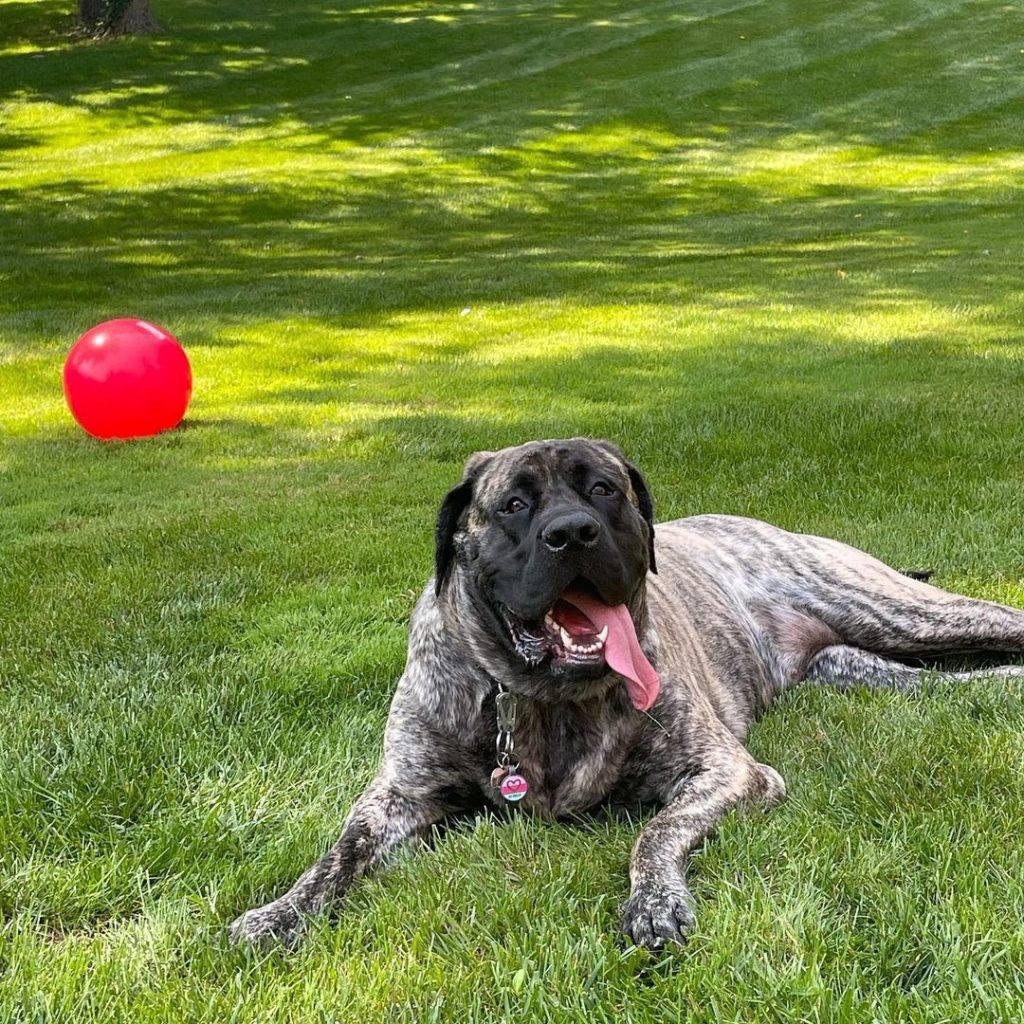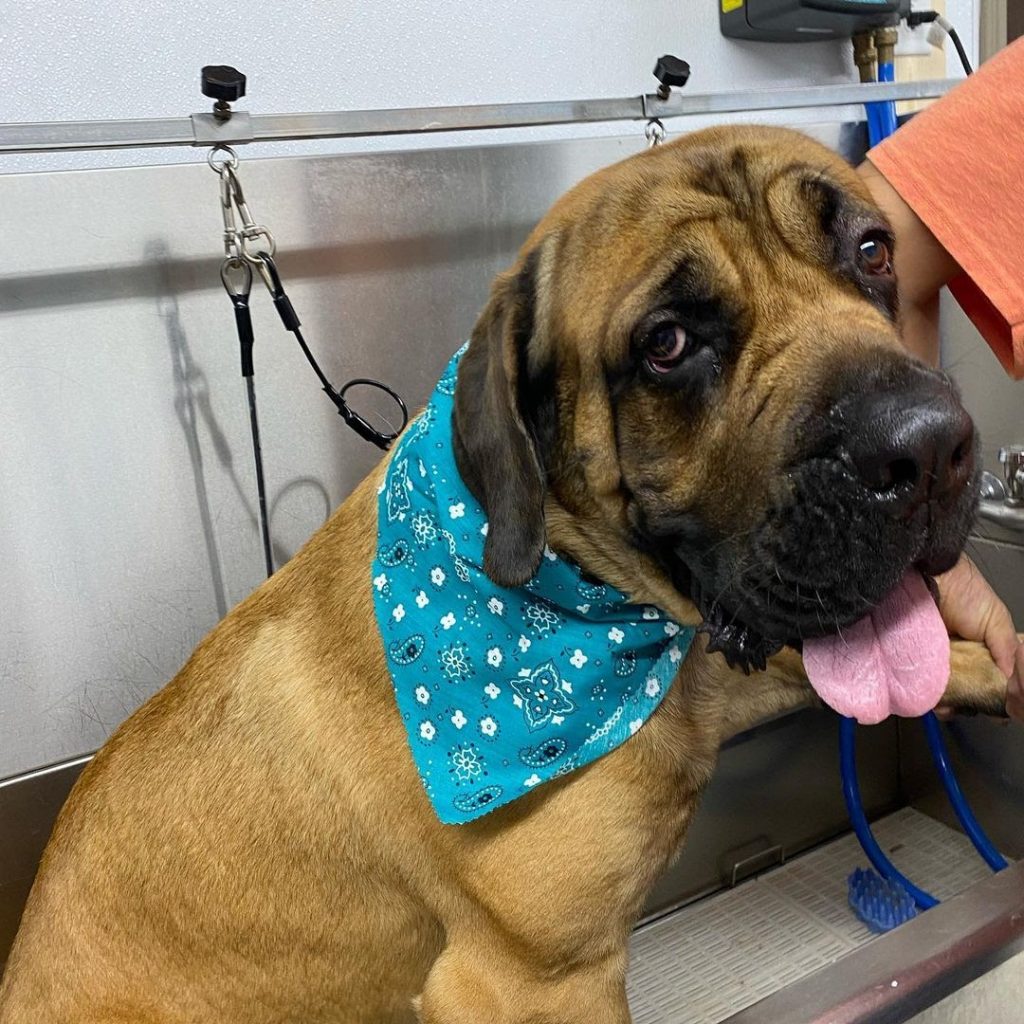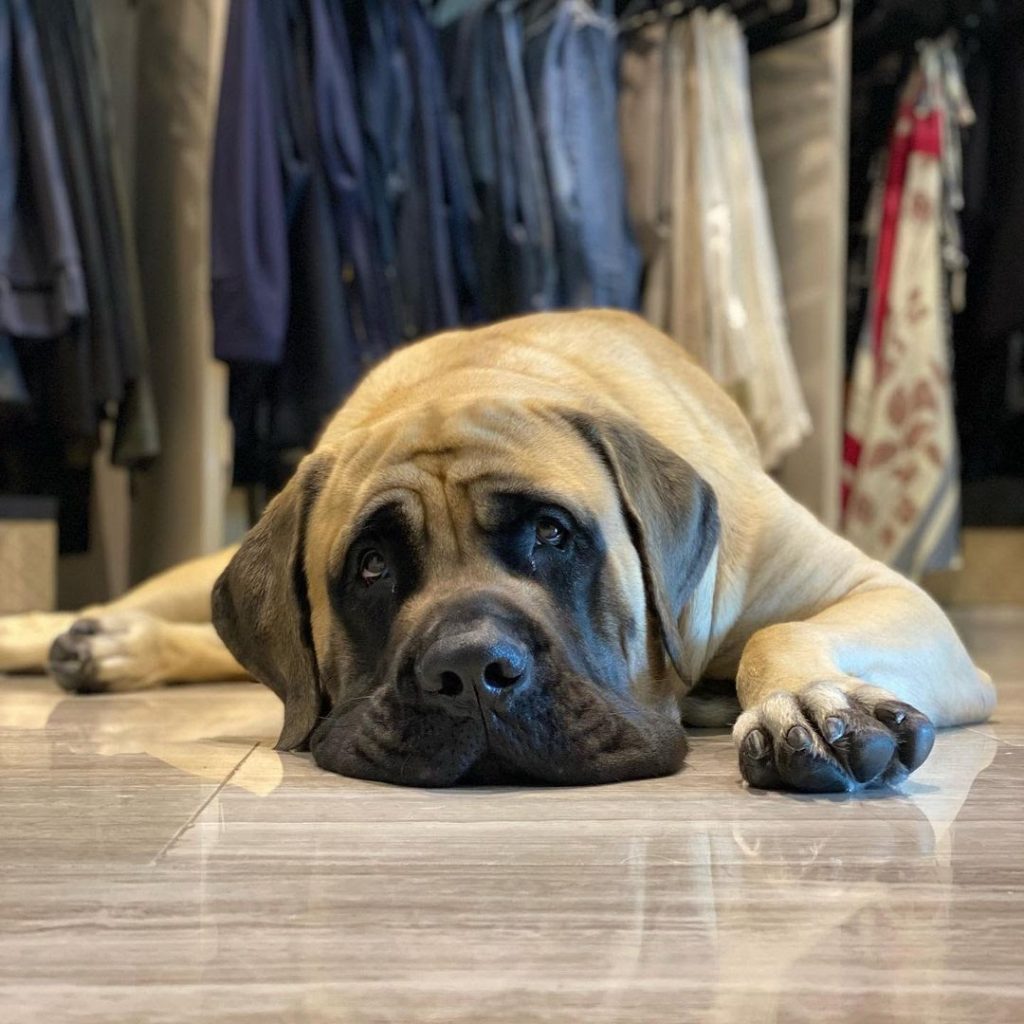English Mastiff 101: The Essential Guide
| Origin | England |
| Size | Giant |
| Height | 27.5 to 30 inches |
| Weight | 120 to 230 pounds |
| Life Expectancy | 6 to 10 years |
| Breed Group | Working Group |
| Affection Level | ⭐⭐⭐ |
| Friendliness | ⭐⭐ |
| Activity Level | ⭐⭐ |
| Barking/Howling Level | ⭐ |
| Pet Friendly | ⭐ |
| Kid-Friendly | ⭐⭐⭐ |
| Shedding | ⭐⭐ |
| Easy to Groom | ⭐⭐ |
| Easy to Train | ⭐⭐ |
Table of Contents
Origin


The English Mastiff or simply referred to as the Mastiff by several kennel clubs comes from the line of an ancient dog breed called the Molossian Hound. This ancestral dog is believed to have come from Tibet or Northern India.
Presumably, these colossal canines were widely used as guard dogs for flocks as they all display very intimidating physical structure and strength in beating up wild threats.
The Molosser’s features and ancestry are evident as well on other dog breeds including Rottweilers, St. Bernard, and Dogue de Bordeaux. History in Greece also depicts dogs that are Mastiff-like fighting off lions through the ancient bas-relief arts which seemed to have been sculpted approximately 2,500 years ago.
For countless decades, English Mastiffs became popular worldwide and were used to either serve as war, guard, or fight dogs. The fame’s scope eventually got even wider when dogs of this breed were transported by traders all over the world.
One remarkable man named Kublai Khan is said to have owned 5,000 Mastiffs in a kennel ready to be used for war and hunting. Later on, when Hannibal who was born from North Africa crossed the mountains, his well-trained Mastiffs were crossed with the local dogs and what resulted were the Rottweilers, St. Bernard, and even the Pug!
After all these events, the Mastiff faced several threats of extinction when dogfighting got banned after 1835. Also, World Wars I and II almost vanquished this dog breed due to extreme food shortages. Thankfully, a pair of puppy Mastiff imports from Canada revived the whole clan of these giant dogs.
Appearance


If you have already seen all the large dog breeds out there, you have to also witness the more massive four-legged dog called the Mastiff. Everything about him is superb as his mass and height can reach incredible measurements.
The American Kennel Club (AKC) gives out a range of possible estimations on how big the Mastiff would get and this is based upon genders:
| Gender | Height | Weight |
| Male | 30 inches up | 160-230 pounds |
| Female | 27.5 inches up | 120-170 pounds |
Typically, Mastiffs sport out a powerful, athletic, and muscular look. They can take down any opponent without breaking a sweat due to their heavy mass and excellent hunting backgrounds.
This dog breed’s head is bulky and square with an obvious short muzzle. There are drooping jowls at the side of his mouth which makes the canine very prone to drooling so ready your towels if you get a Mastiff puppy.
One thing that is very prominent in a Mastiff’s face is his black mask around his eyes, nose, and slightly around his mouth. His ears’ color is also synonymous with his mask’s shade while his tiny eyes are dark hazel to brown. His tail tapers on the tip and its length can reach his rear jock.
As for his short coat, the texture is coarse and straight. Colors include brindle, fawn, and apricot.
Temperament
The large size of a dog does not always equate to danger. The English Mastiff, although capable of fighting off a lion, is considered calm and even-tempered. For families who are considering getting this great canine, it is important to look at some key areas first regarding his behavior.
Affection


Hard and tough on the outside, but a real softy on the inside. That’s the English Mastiff for you. When he’s raised properly, this dog won’t be shy in showing his affectionate side with his family members. Establishing a good relationship with your pet is vital.
This makes his behavior even more desirable making him the most loyal dog you’ll ever have.
Mastiffs can be cuddly. At times, a dog of this breed would prefer sleeping on your lap than lying on his dog bed (expect losing sensation on your legs or whichever part of your body he lays on, so try to keep the blood flowing without waking him up).
Truth be told, within his large size is a mentality that makes him think he can be a lap dog. A Mastiff will sometimes forget that he weighs up to 200 pounds!
Generally, the English Mastiff just loves being around his owner. He shows his affection by trying to wrestle, play, or snuggle with his most important person!
Friendliness


Bringing a Mastiff home should mean considering how this dog would act around kids. Although most dogs, including the English Mastiff, are family-friendly, some aren’t. Luckily, our giant Mastiff shows an incredible reputation for being a reliable family pet due to his good nature.
Loyalty is almost innate for him and his laidback attitude welcomes older children to come and pet him. If you have a toddler, think about getting the Mastiff later after a few years because his size can cause unwanted injuries around very young kids.
If you have other dogs, any type of Mastiff will naturally show aggressiveness to protect its territory. However, the English Mastiff’s gentle nature makes him better to have than others since he can tolerate the presence of other canines around the house.
Activity Level


Despite the size, the English Mastiff does not have very high energy levels making him unsuitable for vigorous activities. He can overheat quickly whilst being in a hot or humid environment. This happens often when its enormous body cannot regulate its body temperature well.
In spite of his incapability to control his body heat, the Mastiff would still need physically stimulating tasks to improve his bones, muscles, and joints. Your pet can be downright lazy and would need a routine. Just simply avoid making your dog do anything that can damage his joints.
Remember, his legs hold a very heavy body.
Care
In getting a puppy, most owners ask how expensive can it be to own a certain breed? Well, for the English Mastiff, he would need more care and resources compared to a smaller pooch. Not that he would need excessive amounts and costly essentials, but it is simply because his size dictates a complimentary supply of needs.
Grooming


The Mastiff might have a short coat, however, he would still require a weekly brushing using a brushing hound glove. By doing so, you are helping remove his dead and loose hairs preventing your house from getting all furry!
He would also need baths which he can take between six to eight weeks depending on his lifestyle. This is necessary since the Mastiff has a dense coat that sheds regularly.
Before indulging him in a refreshing wash, it is recommended that you remove all debris and dirt first using his brush. After that, you may start applying his canine shampoo and conditioner!
Food and Diet


As a rule of thumb, considering that Mastiffs have a maximum weight of 230 pounds, he would need large quantities of wet and dry food which can amount from 6 to 10 cups daily. Of course, this will largely depend on his age, health, and activity level.
If your Mastiff is still a puppy, here’s a general recommendation for his food intake:
| 8-12 weeks | 2-4 cups |
| 3-4 months | 3-6 cups |
| 5-6 months | 5-8 cups |
| 7-10 months | 6-9 cups |
| 11 months onward | 6-10 cups |
Meanwhile, for adult Mastiffs, male dogs would need 8- 10 cups and females would consume 7-9 cups a day. This portion has to be divided into 2-3 meals. Don’t feed everything at once to avoid bloating.
For spayed or neutered Mastiffs, their metabolism is generally lower than those of intact dogs. Feed them fewer amounts which can be 6-8 cups a day.
Exercise


The most suitable exercise for the gentle Mastiff is no other than a peaceful walk. Not that he’s lazy, but this seems to be enough in making him physically stimulated without causing major issues on his delicate joints.
The Kennel Club (UK) suggests that exercise should be done for an hour daily. This has to be divided into different times throughout the day- preferably morning and late afternoon.
Additionally, avoid excessive long walks for this breed as this may contribute to future physical traumas. Mastiff puppies should be taken care of more properly as they tend to give off a more energetic vibe. If they run around carelessly, they will experience injuries related to exercise without your knowing.
As a Mastiff owner, avoid anything physically too much for this heavy canine especially during his first two years. Moreover, stair exercise should not be incorporated as this can be too taxing for the dog’s knees.
Training


English Mastiffs are notorious for being stubborn dogs. They take quite a while before they’d be able to take on a command making owners think that this breed is dumb. However, this all boils down to how you deal with this dog. To make him finish his training quickly, never use punishments or harsh words that can hurt his feelings.
With good reinforcement and his eager-to-please attitude, the Mastiff can learn new tricks in no time.
On another note, all essential training should start as early as puppyhood for Mastiffs. This includes socialization, obedience, crate, and other mentally stimulating tasks.
Health Problems
English Mastiffs are at risk for several health problems. Their susceptibility to medical conditions including other more factors explains why they live for only 6-10 years. The common ones Mastiff owners should be cognizant of are:
- Mitral dysplasia
- Cardiomyopathy
- Bacterial & viral infections
- Pulmonic stenosis
- Joint problems
- Metabolic or digestive disorders
Pros and Cons of Having an English Mastiff
Positives
- Loyal
- Naturally protective
- Cuddly and affectionate
- Powerful
- Can easily adapt
- Low-maintenance grooming
Negatives
- Short attention span in training
- Prone to joint issues
- Unsuitable for very young kids
- Has a short life span
- Bigger food & medical bills
Do Kennel Clubs Recognize the English Mastiff?


The distinguished AKC recognized the English Mastiff breed in 1885. Other several kennel clubs such as that of the UK also acknowledge this dog breed which is already popular worldwide.
Currently, this dog is one among the popular canines with its current standing of 29th out of 200 dog breeds in AKC.
Cost
Going for Mastiff puppies will cost you around $600 to $2,000. The set price, as usual, will be based upon the quality and several other influential factors. In the first year, puppy essentials are estimated to be $4000 which will then lower down by $2200 every year.
In the entire lifetime of the English Mastiff, the cost of owning can be up to $20,000.
Where to Adopt or Buy an English Mastiff
The English Mastiff is a combination of strength, splendor, and charm. Many dog lovers who are fond of larger dogs have Mastiffs popping into their minds when it comes to thinking about which new dog to get. If it’s the same case with you, I have collected several places where you can buy or adopt a great and healthy Mastiff pup at reasonable prices:
BUY
ADOPT
Getting a dog such as a Mastiff is like setting yourself up for a companion who will never leave you alone! He’s a certified velcro dog whose attention will only be mostly given to his human bestfurr-iend. With all the great qualities a Mastiff possesses, every prospective owner should be aware that a larger dog comes with greater responsibility- although not very much overwhelming for the right person.
